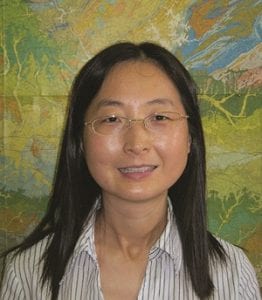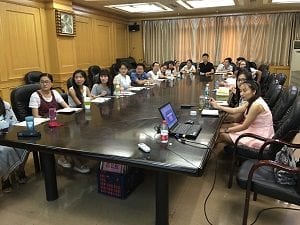Fighting Inequality with GIS

Representing the UCF Department of Sociology is Yingru Li, Ph.D., an assistant professor in Geographical Information Systems (GIS).
With a family background deeply rooted in geography, it was no surprise that Dr. Li went to pursue her master’s degree in GIS and Ph.D. in Geography.
“My father is a geologist,” explained Dr. Li. “When I was little, he always showed me the world map, and told me stories and showed me sceneries all over the world. My husband, who I met in high school, is a geographer with expertise in GIS as well. They both influenced me deeply and encouraged me to choose the geography major.”
Dr. Li’s primary research focus is centered on GIS and spatial statistics, economic and urban geography, and environmental health. Within the past 10 years, she has worked on over 20 scientific projects involving China’s socioeconomic inequalities, retail location analysis and planning, childhood obesity, water quality and environmental pollution and geospatial modeling. As both an educator and researcher, Dr. Li finds joy in combining the two worlds into one.
“I have the opportunity of sharing knowledge with students, colleagues, and societies,” said Dr. Li. “I love experiencing the challenges and solving various problems in my research, disseminating research findings to a wide range of audience, and further contributing to our society.”

Workshop at Henan University that Li organized for undergraduate and graduate students collecting and processing data.
This summer, Dr. Li has been working on a five-year research project supported by the National Natural Science Foundation of China (NSF of China) entitled, “Space-Time Analysis of Intra-provincial Inequality in China: Economic, Transition, Industrial Restructuring and Spatial Agglomeration.” Five research teams composed of professors and students from the U.S., Canada, and China focus on different perspectives of China’s regional inequality and development.
“Recently, we had a meeting with collaborators and stakeholders at the East China Normal University,” said Dr. Li. “Then, I went to Henan University and organized a workshop series for undergraduate and graduate students. Some students have helped collect and process environment and health data for this project.”
Dr. Li’s research team has been collecting data focusing on metropolitan areas such as Beijing-Tianjin and Zhengzhou-Kaifeng. They plan on using GIS, spatial statistics, remote sensing, and hydrologic models to further examine environment and health issues in China.
Read below for more information on Dr. Li’s environment health team’s work in progress.
China’s socioeconomic transitions have dramatically accelerated its economic growth in last three decades, but also companioned with continuous environmental degradation. Our study advanced the knowledge of heavy metal water pollution and the risk on public health in China from a spatial–temporal perspective. Specifically, we addressed the following objectives: (1) spatial patterns of heavy metal water pollution levels and cancer incidences were analyzed with spatial statistical methods; and (2) we explored the associations between health outcome, heavy metal emissions from industrial wastewater (arsenic, chromium, cadmium, mercury, lead), as well as socioeconomic transitions (industrialization, urbanization, globalization) and physical environmental factors (hydrology and vegetation coverage).
The results showed that high heavy metal water pollution levels were closely associated with both anthropogenic activities and physical environments, in particular abundant mineral resources and industrialization prosperity. At the same time, economic development and urbanization play important roles in controlling water pollution problems. In addition, we found a significant increase of cancer incidences over time. Consistent with the spatial pattern of heavy metal emissions, cancer patient clusters were identified in both traditional industrial bases and newly industrialized economic zones, especially in major cities located at downstream watersheds, including Beijing, Shanghai, Guangzhou, Shenyang, and Wuhan. The findings revealed the double-edged effects of industrialization, economic growth, and urbanization on natural environment and human health.
